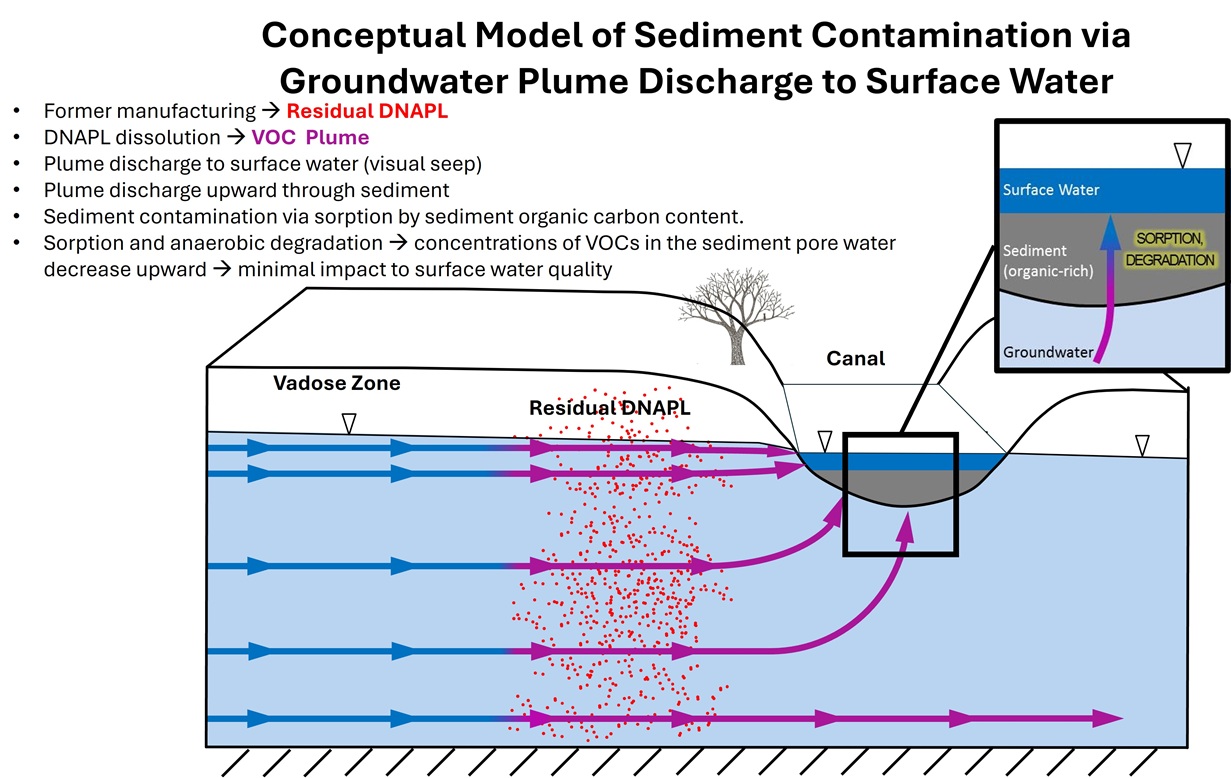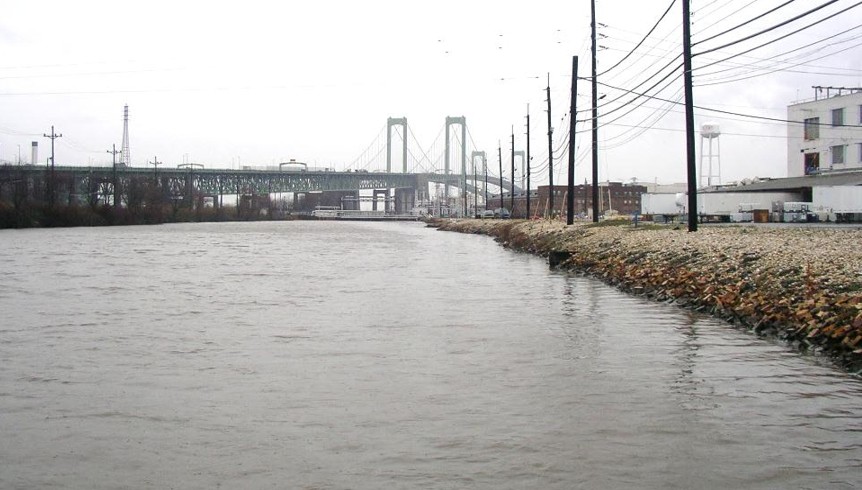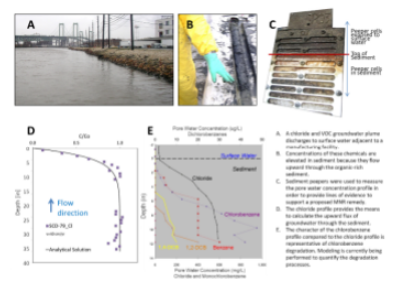Investigation, design, Conceptual Site Model development, and remedial selection for sediment contaminated with VOCs and aniline. Project included high-resolution profiling of sediment pore water concentrations, sediment pore water transport modeling, bench-scale tests to assess efficacy of a Geosynthetic Bentonite Liner cap, and design of a sheet pile barrier to prevent groundwater plume discharge to surface water. Fate and transport modeling in concert with measured sediment pore water profile data to quantify groundwater-sediment-surface water interaction and degradation of chlorobenzene in sediment.
Elevated concentrations of chlorobenzene and other VOCs are present in the organic-rich, silty sediment of nearby canal, which is located adjacent to the plant. An Interim Remedial Action (IRA) was initiated in 2008. The IRA includes a sheet pile barrier (SPB) to mitigate groundwater plume discharge to the canal and Monitored Natural Recovery (MNR) for sediment.
A sediment pore water evaluation focused on understanding the behavior and fate of chlorobenzene and other volatile organic compounds (VOCs) in sediment adjacent to a historical industrial site. The investigation was conducted to assess whether monitored natural recovery (MNR) was effectively reducing contaminant bioavailability, particularly in light of a sheet pile barrier (SPB) installed to prevent further groundwater discharge into the canal. My analysis involved an extensive comparison of pore water sampling methods, evaluation of spatial and temporal variability in sediment contamination, and numerical modeling of solute transport in sediment.
Data Analysis and Methodology
The project required a rigorous assessment of multiple datasets collected before and after the SPB installation, spanning 2004 to 2011. This included:
· Pore water concentration measurements using different methods, including sediment peepers, centrifugation, and partitioning estimates.
· Hydraulic gradient analysis to determine whether groundwater was still discharging through the sediment after SPB installation.
· Carbon-normalized sediment concentration calculations to assess changes in VOC bioavailability over time.
· Numerical modeling of solute fate and transport to evaluate degradation rates and contaminant migration mechanisms.
The pore water analysis was particularly critical in assessing contaminant bioavailability. Among the sampling methods tested, sediment peepers provided the most reliable pore water concentration data, while centrifuge-based measurements tended to overestimate concentrations, likely due to colloidal organic carbon interference. I also demonstrated that the commonly used partitioning equation was unreliable for estimating pore water concentrations, as the organic carbon partition coefficient (Koc) varied by a factor of 35 across different sediment samples. This finding had significant implications, as it indicated that traditional sediment concentration benchmarks might not accurately reflect actual contaminant bioavailability.
Mathematical Modeling and Interpretation
To further investigate contaminant fate, I applied an analytical solute transport model to match measured pore water concentration profiles and estimate chlorobenzene degradation rates. However, the model results revealed an issue:
· The estimated degradation half-life required to fit the data was unrealistically short, suggesting that biodegradation alone could not explain the observed contaminant trends.
· An alternative hypothesis was proposed—an advancing solute front was driving the chlorobenzene concentration profiles, consistent with the increasing concentrations observed in 2011.
· Additional solute transport mechanisms, including transient contaminant migration and solute buoyancy effects, were explored to explain the anomalous data patterns.
Value of the Analysis
My work provided key insights into contaminant dynamics in sediment and groundwater at the site. The findings had direct implications for remedial decision-making:
· Demonstrated that ongoing groundwater discharge into the sediment could continue to transport contaminants, necessitating further evaluation of hydraulic controls.
· Showed that traditional bulk sediment concentration measurements were inadequate for assessing bioavailability, highlighting the need for pore water-based monitoring approaches.
· Provided a quantitative framework for evaluating contaminant fate and transport, supporting the development of a more accurate conceptual site model (CSM).
· Identified limitations in existing degradation assumptions, which could impact the selection of future remediation strategies.
By integrating high-resolution pore water data, hydraulic evaluations, and solute transport modeling, my analysis refined the understanding of site conditions and provided a scientifically defensible basis for improving MNR monitoring and sediment management decisions.
Contaminants included:
1,2,4-trichlorobenzene
1,2-dichlorobenzene
4-chloroaniline
Aniline
Benzene
Carbazole
Chlorobenzene
Dichlorobenzenes
Diphenylamine
Ethylbenzene
Naphthalene
N-Nitrosodiphenylamine
o-Toluidine
PAHs
PCE and TCE
Toluene
Trichlorobenzene
Xylene



